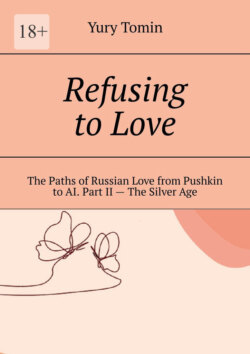Читать книгу Refusing to Love. The Paths of Russian Love from Pushkin to AI. Part II – The Silver Age - Yury Tomin - Страница 5
На сайте Литреса книга снята с продажи.
III
ОглавлениеRendezvous in a remote restaurant. Damn confused. The attraction of the amethyst ring. Deadly compromises of high love. A tribute to sensuality. Self-poisoning with love. Guardian of the threshold to the supersensual world. Work on the temples of the body. Temptations of bright chivalry. Victory over mania. Berlin’s pubs madness
In February 1912, in a modest restaurant in St. Petersburg, Alexander Blok and Andrei Bely met again, who, even before their first meeting in January 1904, when the beautiful young married couple of Bloks visited in Moscow the close acquaintance in absentia poet-symbolist Andrei Bely, were forever bound by the spiritual kinship of «seeking the way» to «new dawns», and then «the devil misled», taking Blok from the brotherhood of the servants of the Beautiful Lady to the Night Violet, weaving the lace of love between Bely and Blok’s wife, bringing Bely to the brink of murder or suicide and «hatching» the decision to call Blok to duel, but could not break the thinnest threads connecting these «two sons of harmony.» In the fate of both, this was the period of the formation of a new stage of life, when, having lost their way, brightly illuminated by the dawns of symbolism, after evil blizzards and «the whirling of endless, ugly demons,» each found himself far after the inevitable fork in the road. Blok shared his spiritual path with Strindberg, and Bely was pushed by providence into the arms of Steiner’s witnesses and the trails of anthroposophy.
Wishing to support Blok, who, as Bely felt, suffered in his «tormenting life,» being carried away by gypsies, wine, and random women, he spoke in detail about his own inner life, in which esotericism, the secrets of initiates, spiritual exercises emerged as inevitable milestones of destiny, colliding first with the missionary of occultism in Russia Anna Mintslova, who gave Bely, before her mysterious disappearance, a ring with the emblem of the Rosicrucian brotherhood and «several evangelical sayings – as „identification marks“ in case of a possible meeting,» and then with the artist Asya (Anna Turgeneva) who was prone to mysticism. Moreover, in Asya, Bely apparently still found a compromise «between Divine and non-divine love,» abandoning his own conviction that «the greatest insight of the world should not approach middle ground.» Blok, who was less impressed with Asya than her sister Natasha upon meeting her, asked whether Bely was happy with his relationship with Asya, «and on learning that he was, it was as if he were surprised; but – he said nothing.»
Boris Nikolaevich Bugaev – Andrei Bely (1880—1934)
With the «compromise» of high love, Bely had already twice experienced a mortal combat. At the end of 1903, he became close to Nina Petrovskaya, a member of literary circles, who had the ability to listen with understanding to Bely’s spiritual outpourings, so that he considered her like-minded in the necessity of knowing God in oneself through «mystical love for the Soul of the World,» which, being transferred to the «earthly image» would only be a return to pagan practices of love. When spiritual intimacy involuntarily turned into romantic rapprochement, Bely had to experience the harsh consequences of his «fall.»
